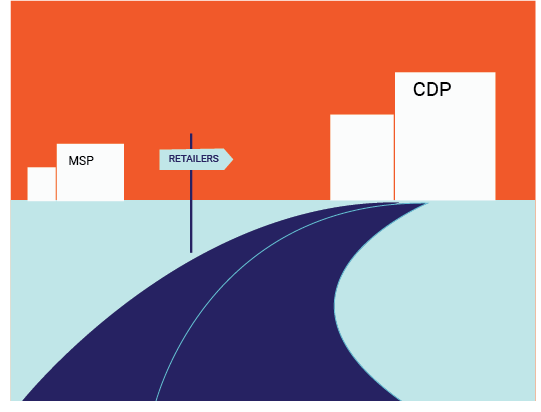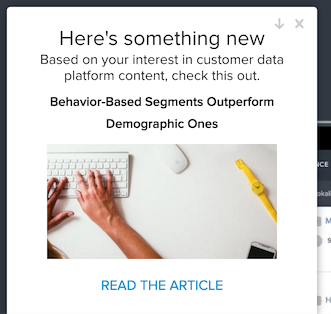Using CDPs to Support Analytics
February 14, 2017It may seem self-evident that the reason marketers create a unified customer view is to give customers a unified experience (or, more precisely, an optimal experience driven by unified data). But when the CDP Institute recently asked marketers to rank uses for a single customer view, “consistent treatments” was far down the list. Generic “personalization” came first, followed closely by two analytical uses: “customer insights” and “measure across channels”. Other research gives similar answers about the importance of analytics as a reason for assembling customer data. So it’s worth looking more closely at this counter-intuitive result.
Let’s start with the most basic question: why do marketers want analytics at all? There are plenty of reasons, including understanding their customers, tracking customer behavior, identifying segments for promotions, and measuring promotion results. What these all share is they require a cross-channel view of the customer, which can’t be provided by systems that execute email, Web sites, mobile apps, ad placements, call centers, or retail point of sale. In addition, many execution systems have limited reporting features for their data. This is why marketers often purchase separate systems to do Web analytics, social analytics, customer satisfaction surveys, or interaction analysis. Marketers also want advanced analytic functions such as predictive models, recommendations, and optimization. These are beyond the capabilities of most channel systems and often require cross-channel data.
So we see that many of marketers’ analytics needs cannot be met by their execution systems. The first step to closing the gap is to pull data into a data store that’s designed for analytical projects. For projects that only need data from one channel, the next step is simply to hook up specialized analytical tools. For projects that need a cross-channel view, the next step is to link data related to the same customer. That unified view, in turn, is made available to the analytical tools.
Of course, what we’ve just described is the process of building a Customer Data Platform. So it begins to make sense that marketers would consider analytics a major application for the CDP database. This doesn’t mean the CDP must provide analytical tools, although some do. Rather, it means the CDP is preparing data for access by analytical tools, whether or not those tools are part of the CDP.
Let’s look more closely at CDP capabilities that can support analytical uses. Remember that not all of these are provided by every CDP – or needed by every CDP buyer.
- multiple data types: marketing data includes structured data, such as purchase transactions; semi-structured data such as Web logs; unstructured data such as social media posts; and other formats including images, video, and audio. These come from disparate systems that often use different technologies. It’s important for the CDP to ingest all those data types, tag them for access, and place them into a single data store. This makes it easier for analysts to find them and lets analysts use a single toolkit for further processing.
- easily add new sources: marketers are constantly adding new data sources, often as part of tests to measure the sources’ value. Being able to incorporate new data with minimal effort makes it much easier to evaluate new sources and new information from existing sources. This lets marketers try more things and quickly assess which are worth keeping.
- persistent, detailed data: analysis often requires examining historical data in fine-grained detail, sometimes down to individual mouse clicks or even hovers. Exactly which data will be needed in the future isn’t known when the data is captured. The CDP gives marketers an easily-accessible place to store raw data and later retrieve whatever portions are needed. Source systems often discard such data because they don’t need it for operational tasks.
- data cleaning: analysts spend the bulk of their time preparing data to make it useful – 80% by one estimate*. Typical tasks include removing anomalies, standardizing values, and harmonizing formats. A CDP that cleans data as it’s loaded makes the data available for use with minimal additional effort. This is especially helpful when different analysts might otherwise be performing the same preparation tasks or when the same analyst might be repeating the tasks at different times. A CDP can also provide a central place to document cleaning processes so everyone can understand what was done to the data and so processes can be vetted and improved over time.
- transformations: a CDP can also calculate summary statistics that are used in common analyses, such as cumulative purchases, average, and trends. Like cleaning processes, these are easier to do once when data is loaded into the CDP, than separately for each new project. Some CDPs can also check for behavior patterns or deviations from patterns, extract information from unstructured source data, and apply tags based on the extracted data.
- anonymization: customer data often should, or must, have personal identifiers removed before it can be used for analysis. This is another process that the CDP could do once rather than relying on analysts to apply their own procedures.
- identity resolution: many analyses rely heavily on assembling cross-channel profiles. This is a core CDP function that relies heavily on historical data and complex, carefully designed and tested processes. Having it centralized and documented saves time and ensures consistency across analyses. (To be clear, not all CDPs do this. Those that don’t may be used in situations where it’s not needed or may integrate with external identity resolution services.)
- restructuring: CDP data often must be converted into new formats before analytical systems can use it. This might mean converting distributed files like Hadoop into relational tables like SQL or converting relational tables into flat files. When the information to be restructured is known in advance, the CDP can do this on a regular basis rather than requiring analysts to do it separately for each project. Restructuring can also include other changes such as creating indexes or summary tables.
- extraction: even when the specific data to be restructured isn’t known in advance, the CDP can provide standard tools to do custom extracts. These can save analysts from creating custom extraction processes, saving time and reducing the chance for error.
Once again: not every CDP will provide the functions just listed. CDPs that do provide these functions will differ substantially in exactly what they offer. So while it’s important to recognize analytics support as a key CDP benefit, marketers also need to ensure they purchase a CDP that actually meets their analytical needs. As with any application, this means they must start by defining how they’ll use the data, work backwards from that to define the functions needed to support those uses, and then carefully evaluate potential CDPs to understand how they perform those functions.
* Crowdflower, 2016 Data Science Report, http://visit.crowdflower.com/data-science-report.html


